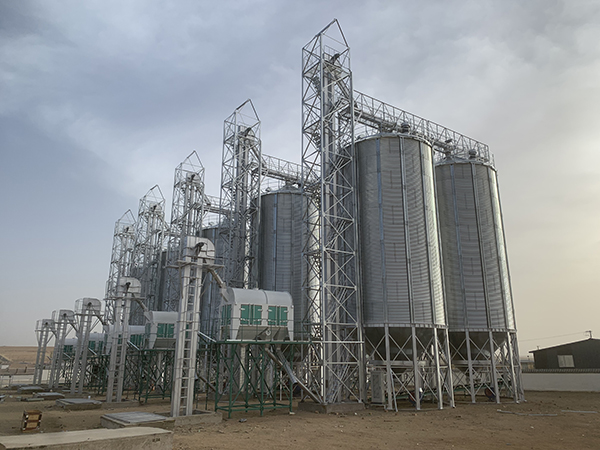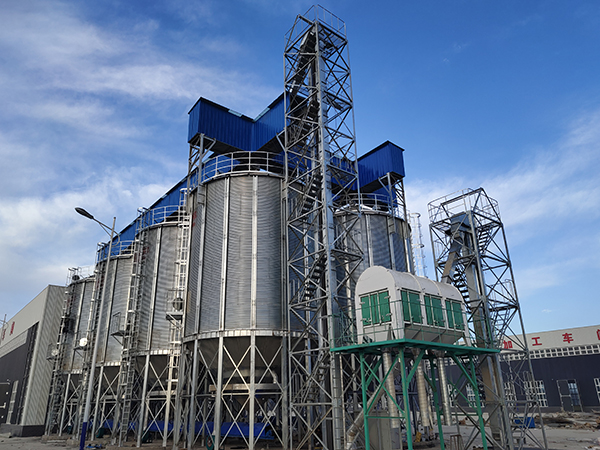Horse feed silo
horse feed silo is typically a facility used for storing and managing horse feed, structured like a large silo specifically for storing horse feed such as hay
Horse feed silo Introduction
“A horse feed silo” is typically a facility used for storing and managing horse feed, structured like a large silo specifically for storing horse feed such as hay, grains, and other supplementary feed. This type of silo generally has a certain capacity to store a large quantity of feed to meet the feeding needs of multiple horses. Horse feed silos are typically designed to be relatively sealed to prevent feed from being affected by moisture, pests, or other contaminants, ensuring the quality and freshness of the feed. These silos are usually installed in stables or other suitable locations for the convenience of caregivers to manage and use horse feed.

Features of horse feed silo
Large capacity
Horse feed silo typically have a large capacity, allowing for the storage of a significant quantity of feed to meet the needs of multiple horses.
Strong sealing
Silos are usually designed with strong sealing to prevent feed from being affected by moisture, pests, or other contaminants, ensuring the quality and freshness of the feed.
Convenient management
The structural design of horse feed silos facilitates easy storage, retrieval, and management of horse feed by caregivers.
Maintenance of feed quality
Silos effectively maintain the quality of feed, protecting it from external environmental factors and preserving its nutritional value and palatability.
Economical efficiency
By storing feed in silos, feed supply can be managed more effectively, reducing waste, improving feed utilization, and ultimately saving costs.
Customizability
Horse feed silo can be customized in terms of size and design to meet specific needs and requirements based on the feeding facility and the number of horses.


Structure of horse feed silo
Silo body
The silo body forms the main part of the structure, usually made of metal or concrete, with a large capacity for storing feed.
Inlet port
The inlet port is where feed is introduced into the silo, often located at the top or side of the silo for easy loading.
Outlet port
The outlet port is where feed is retrieved, usually situated at the bottom or side of the silo to allow feed to be dispensed into feeding troughs or other containers.
Sealing system
Silos are typically equipped with a sealing system, including sealed doors or covers, to ensure that the feed inside the silo is protected from moisture, pests, or other contaminants.
Ventilation system
Some silos are equipped with a ventilation system to maintain airflow within the silo and keep the feed fresh by effectively removing moisture and odors.
Supporting structure
To support the silo body and maintain its stability, supporting structures such as pillars or brackets are usually installed around the silo.
These components together form the basic structure of a horse feed silo, ensuring the safe storage and efficient management of feed.


Advantages of Horse Feed Silo
Large capacity
Horse feed silo typically have a large capacity, allowing for the storage of a significant quantity of feed to meet the needs of multiple horses.
Effective management
The silo’s structural design facilitates easy management and organization of feed, enabling caregivers to store, retrieve, and manage horse feed efficiently, saving time and effort.
Maintenance of feed quality
Silos usually feature good sealing and ventilation systems, effectively preserving the quality of the feed by preventing it from being affected by moisture, pests, or other contaminants, ensuring its nutritional value and palatability.
Cost savings
By effectively managing and storing feed, waste can be reduced, feed utilization can be improved, leading to cost savings in horse care.
High space utilization
Horse feed silos are typically designed as vertical structures, allowing for the storage of a large amount of feed in limited space, saving space and making feed more accessible and manageable.
Customizability
Depending on the specific needs and requirements of the feeding facility and the number of horses, horse feed silos can be customized in terms of size and design.
In summary, horse feed silos offer many advantages such as convenient management, cost savings, and maintenance of feed quality, making them an essential facility in modern horse feeding management.

Horse feed silo applications
Horse farms and stables
Horse farms and stables are common places for horse breeding. Horse feed silo can be used to store and manage horse feed, ensuring the quality and supply of feed.
Racetracks
Racetracks require a large supply of feed to meet the needs of competing horses. Horse feed silos can effectively manage and provide sufficient feed.
Equestrian training centers
Equestrian training centers typically have multiple horses that need to be fed and managed. Horse feed silo can assist managers in organizing and supplying feed effectively.
Farms and ranches
Farms and ranches may utilize horse feed silo to store feed for grazing horses or those undergoing short-term feeding.
Equestrian competitions and exhibitions
Adequate feed is required for participating horses in equestrian competitions and exhibitions. Horse feed silo can help organizers meet these needs.
Horse feed silo technical parameters
Scientifically speaking, the Silo capacity should be measured with volume (m3). Even in the same grain Silo, the storage tons will be different for different grains with different densities. The following table is calculated based on a Silo density of 0.75kg/m3, and surely HKB customizes Silo systems unique for you.
| Most Popular Hopper Bottom Steel Silo Technical Specifications | ||||||||
| Capacity | 50Ton | 100Ton | 150Ton | 200Ton | 300Ton | 500Ton | 1000Ton | 1500Ton |
| Model | TCZK
03605 |
TCZK
04507 |
TCZK
05507 |
TCZK
06406 |
TCZK
07307 |
TCZK
07313 |
TCZK
11010 |
TCZK
12811 |
| Diameter(m) | 3.667 | 4.584 | 5.500 | 6.417 | 7.334 | 7.334 | 11.000 | 12.834 |
| Total Height(m) | 9.56 | 12.53 | 13.25 | 12.85 | 14.70 | 21.42 | 20.95 | 23.51 |
| Volume(m³)
Density:0.75ton/m³ |
69 | 150 | 222 | 273 | 415 | 699 | 1346 | 2039 |
| Most Popular Flat Bottom Steel Silo Technical Specifications | ||||||||
| Capacity | 1000Ton | 1500Ton | 2000Ton | 2500Ton | 3000Ton | 5000Ton | 8000Ton | 10000Ton |
| Model | TCK
10014 |
TCK
11915 |
TCK
13715 |
TCK
15514 |
TCK
15518 |
TCK
18321 |
TCK
24718 |
TCK
25621 |
| Diameter(m) | 10.084 | 11.918 | 13.750 | 15.584 | 15.584 | 18.334 | 24.751 | 25.668 |
| Total Height(m) | 18.69 | 20.34 | 20.87 | 20.30 | 24.78 | 28.60 | 26.99 | 30.60 |
| Volume(m³)
Density: 0.75ton/m³ |
1335 | 2009 | 2701 | 2467 | 4145 | 6693 | 10879 | 13484 |









